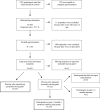The relationship between chronic pain and health-related quality of life in long-term social assistance recipients in Norway
- PMID: 20652418
- PMCID: PMC2977061
- DOI: 10.1007/s11136-010-9707-4
The relationship between chronic pain and health-related quality of life in long-term social assistance recipients in Norway
Abstract
Purpose: The purposes of this study were to compare the health-related quality of life (HRQOL) of long-term social assistance recipients (LTRs) with and without chronic pain and determine the effect of select demographic, social, pain, alcohol, and illicit drug use characteristics on the physical and mental components of their HRQOL.
Methods: In this cross-sectional study, which is part of a larger study that evaluated the health and functional abilities of LTRs in Norway, 405 LTRs of which 178 had chronic pain were recruited from 14 of 433 municipalities.
Results: LTRs with chronic pain were older (P < .001), more often married (P = .002), feeling more lonely, (P = .048), and had more problems with alcohol (P = .035). The final regression model explained 41.2% (P < .001) of the variance in PCS scores and 32.2% (P < .001) of the variance in MCS scores. Being in chronic pain (29.7%), being older (4.7%), and never married (2%) predicted worse PCS scores. Feeling lonely (11.9%), having problems with illicit drug use (5.9%), and being in chronic pain (2.9%) predicted worse MCS scores.
Conclusion: LTRs with chronic pain rated both the physical and mental components of HRQOL lower than LTRs without chronic pain. The MCS score in both groups was negatively effected.
Figures


Similar articles
-
The co-occurrence of chronic pain and psychological distress and its associations with salient socio-demographic characteristics among long-term social assistance recipients in Norway.Scand J Pain. 2016 Apr;11:65-72. doi: 10.1016/j.sjpain.2015.12.003. Epub 2016 Jan 5. Scand J Pain. 2016. PMID: 28850472
-
Prevalence and characteristics of chronic pain among long-term social assistance recipients compared to the general population in Norway.Clin J Pain. 2010 Sep;26(7):624-30. doi: 10.1097/AJP.0b013e3181e0de43. Clin J Pain. 2010. PMID: 20639732
-
Ethnicity does not account for differences in the health-related quality of life of Turkish, Moroccan, and Moluccan elderly in the Netherlands.Health Qual Life Outcomes. 2014 Oct 1;12:138. doi: 10.1186/s12955-014-0138-8. Health Qual Life Outcomes. 2014. PMID: 25269442 Free PMC article. Clinical Trial.
-
Psychological distress and quality of life in long-term social assistance recipients compared to the Norwegian population.Scand J Public Health. 2011 May;39(3):303-11. doi: 10.1177/1403494811401475. Epub 2011 Mar 15. Scand J Public Health. 2011. PMID: 21406477
-
Health-related quality of life in adults with congenital unilateral upper limb deficiency in Norway. A cross-sectional study.Disabil Rehabil. 2016 Nov;38(23):2305-14. doi: 10.3109/09638288.2015.1129450. Epub 2016 Jan 18. Disabil Rehabil. 2016. PMID: 26778109
Cited by
-
Self-rated quality of life of city-dwelling elderly people benefitting from social help: results of a cross-sectional study.Health Qual Life Outcomes. 2013 Oct 29;11:181. doi: 10.1186/1477-7525-11-181. Health Qual Life Outcomes. 2013. PMID: 24168471 Free PMC article.
-
Pain rehabilitation's dual power: Treatment for chronic pain and prevention of opioid-related risks.Am Psychol. 2020 Sep;75(6):825-839. doi: 10.1037/amp0000663. Am Psychol. 2020. PMID: 32915026 Free PMC article.
-
Transforming pain medicine: adapting to science and society.Eur J Pain. 2013 Sep;17(8):1109-25. doi: 10.1002/j.1532-2149.2013.00297.x. Epub 2013 Mar 7. Eur J Pain. 2013. PMID: 23468059 Free PMC article. Review.
-
Systematic review and meta-analysis on non-opioid analgesics in palliative medicine.J Cachexia Sarcopenia Muscle. 2018 Dec;9(7):1235-1254. doi: 10.1002/jcsm.12352. Epub 2018 Oct 29. J Cachexia Sarcopenia Muscle. 2018. PMID: 30375188 Free PMC article.
-
Occurrence and characteristics of chronic pain in a community-based cohort of indigent adults living with HIV infection.J Pain. 2011 Sep;12(9):1004-16. doi: 10.1016/j.jpain.2011.04.002. J Pain. 2011. PMID: 21684218 Free PMC article.
References
-
- Sosial-og helsedirektoratet . Utviklingstrekk i helse- og sosialsektoren. Oslo: Sosial- og helsedirektoratet; 2007.
-
- SSB . Økonomi og levekår for ulike grupper. Oslo: Statistics of Norway; 2008. p. 147.
-
- Myklestad I, Rognerud M, Johansen OR. Utsatte grupper og psykisk helse. Oslo: Folkehelseinstituttet; 2008.
-
- van der Wel K, Dahl E, Lødemel I, Løyland B, Ohrem Naper S, Slagsvold M. Funksjonsevne hos langtidsmottakere av sosialhjelp. Oslo: Høgskolen i Oslo; 2006.

